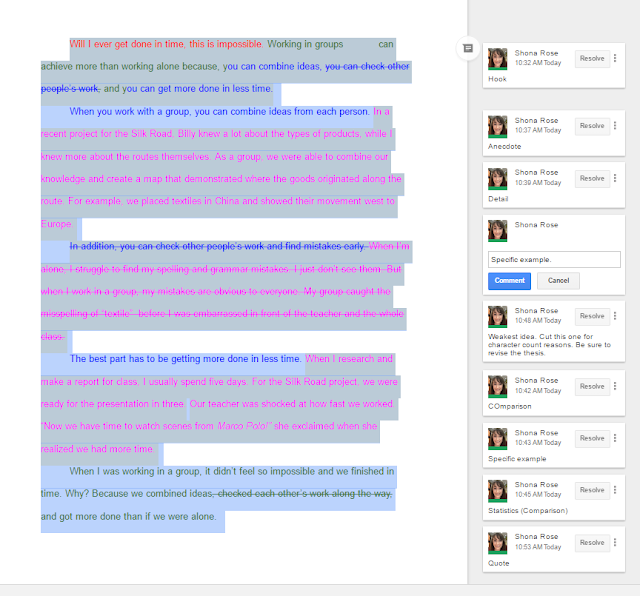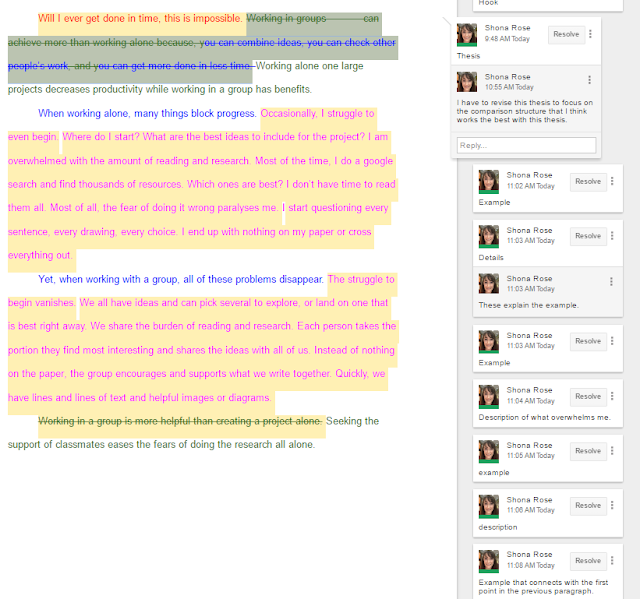"Having a positive attitude is a thing that is a very successful think in your life. Having a positive mind is very enjoyable because you can do a lot more things in your life."
Students were repeating, adding nothing new.
"When you learn from lying, it can help you a lot. When you stop lying, people trust you more often. It helps if you don't lie a lot."
Students had paragraphs and reasons, but structure and development were missing.
We took apart one of the essays to examine the developmental patterns the writer was using.
And can we tell you that explicitly naming the moves the writer was making was difficult for us? We had to do a lot of talking to decide exactly what the writer was doing. If we don't know what to call it...
Kim and I stared talking about how she was teaching development. She emphasized supporting details with this graphic.
What we realized: Students don't know what supporting details are. Students really don't know what we are talking about when we ask them to develop their ideas. How could we be more explicit with our students?
Julie Vick gave a wonderful presentation at the Abydos conference last week. We used her ideas for Conquering Coherence: Respond with Color! as a frame for our work.
Together, we created three models to revise this essay. The best way to improve to more advanced score points happens when we REVISE what we have already written. We wanted to create models that give students a clear picture of what we expect them to do.
- In the first essay model, we used CAFE SQUIDD to develop an essay that utilized only ONE main idea: (Note - the thesis is green. Main idea/topic is blue. Pink is development.)
2. Next, we created a model that uses pairs of CAFE SQUIDD to develop three main ideas/topics. (We did this because the original essay had a three pronged thesis. While we really don't recommend a five paragraph essay structure often, this writer chose to do so. In addition, sometimes kids don't have much to say about the topic. They need the flexibility of more reasons to support their ideas.)
While creating this model, we wrote down the thesis, then immediately composed the main idea sentences that offered reasons for the thesis. Then we read the main idea sentence and referenced the CAFE SQUIDD chart. We asked ourselves: What two CAFE SQUIDD pairs seem to match what we could say about this idea? It was important to pick two. We made a statement and then used a second one to develop the idea presented in the previous statement.
Some things to note.
- The original essay had a hook. That is displayed in red. Kim and I think that we might be spending more time on a hook than necessary. If you have a good one, fine. But the most important thing to do in 26 lines or 1250 characters is to have something meaningful to say in the body of the paper. The rubric privileges development, not interesting beginnings.
- When we used the CAFE SQUIDD pairs, we realized that we used too many characters. We looked back at the paper to find the weakest point. Then we pressed delete. (Actually, I learned that you can press alt, shift, and 5 to make a strike through.) Then we realized that we needed to revise the thesis to remove the idea we didn't use.
3. Finally, we realized that sometimes, writers can use text structures to organize the whole essay. We decided that comparison would fit well with this topic. We decided to create two paragraphs, one for working alone and one for working with a group. After we composed the first paragraph, we used that paragraph to match, point by point, the comparison to working as a group. We used pairs of CAFE SQUIDD here as well.
Here's the link to the google docs so you can see the comments more closely.





Hi, Shona! Y'all are doing some great work making paragraph development concrete! Your Google doc is such a good idea. Shout out to Dr. JAC for Cafe Squidd, huh?! My kids couldn't survive without it! Here's a high five from Birdville HS to you and your team!
ReplyDelete